From the Northern Veg Crew:
During the past few weeks of vegetation sampling the northern crew ran into some heavily fenced and posted land. A quick and lucky phone call granted permission to park our truck and pass through the heavily gated water authority property in order to get to one of our priority plots. Our second option to gain access to this plot would require far more driving on secondary roads.
The following week we figured our easiest route to one of our plots was through a private landowner’s property. I had met this landowner previously as he had given us permission to access a different plot last year. Accompanied by his Swiss mountain dog pup, we were given a tour of his ponds and hatchery. This man has a true appreciation for nature and we spent some time speaking with him about our sightings and findings throughout our journeys.
During our last treatment plot, we met a group of loggers which included a young and very playful German shepherd.  It isn’t often we run into other people working in the woods. We asked questions about their equipment on site, the problems they run into while harvesting, and chatted about the typical wildlife sightings/stories.
It isn’t often we run into other people working in the woods. We asked questions about their equipment on site, the problems they run into while harvesting, and chatted about the typical wildlife sightings/stories.
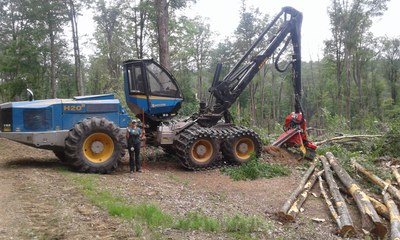
We have seen the slight shift of late spring/early summer flowering plants –
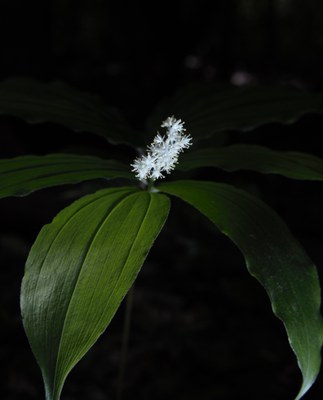
Solomon’s plume (false Solomon’s seal)
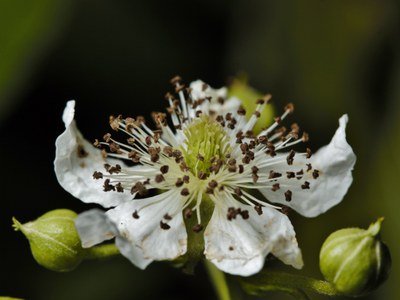
Blackberry and raspberry (rubus)
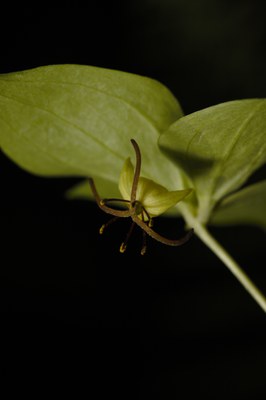
Indian cucumber root as well as enchanters nightshade, wood nettle, and others.
Along with late bloomers, the crew had a fun deciphering between two species which already flowered and are basically vegetatively identical.
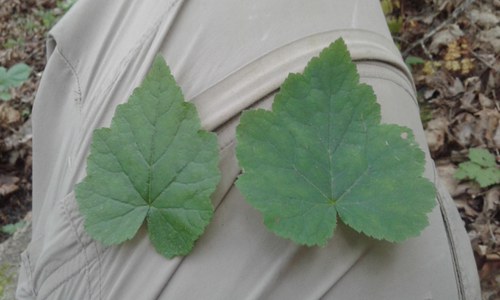
Looking at old inflorescences helps.
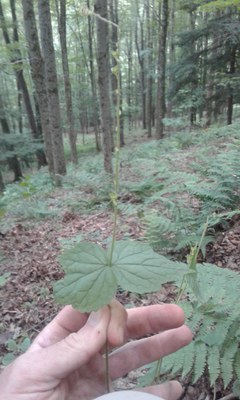
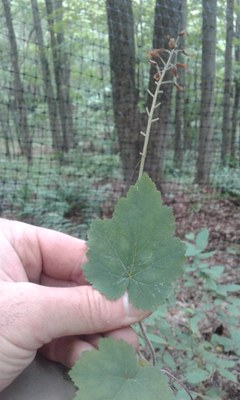
But without any signs of old flowers, foam flower and bishop’s cap are very hard to tell apart just by looking at leaves.
Deer exclosure fences have mostly been successful keeping deer out of our fenced plot areas. We have only found a few fences which have a single bent t-post or sagging fences which are easily fixed.
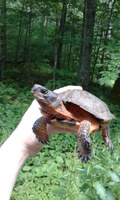 Finally, we have encountered our first collared doe while leaving one of our study areas! Other wildlife encounters included a decent sized black bear about 60 yards away and another female wood turtle crossing Long Toe road.
Finally, we have encountered our first collared doe while leaving one of our study areas! Other wildlife encounters included a decent sized black bear about 60 yards away and another female wood turtle crossing Long Toe road.
Northern Veg Crew
From the Southern Veg Crew:
Long drives, tough hikes, and wet weather were the norm this week. The majority of the time was spent deep in the wild and remote areas of Bald Eagle State Forest. Several times, we were forced to drive down what I’m convinced are the worst roads in the forest.
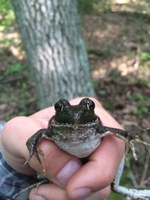 One new and muddy road in Rothrock State Forest led us to our first treatment plot of the week. Here, while collecting data, we accidentally disturbed a family of flying squirrels! I was testing the sturdiness of an old chestnut oak snag that looked like it was ready to come down, and out popped 4 of the secretive and extremely cute oddballs. One “took flight” and landed at the base of a white oak right next to us! The others sat atop their home staring at us and eventually made their way back into the tree. But they kept their heads poking out to keep an eye on us. It was an incredible.
One new and muddy road in Rothrock State Forest led us to our first treatment plot of the week. Here, while collecting data, we accidentally disturbed a family of flying squirrels! I was testing the sturdiness of an old chestnut oak snag that looked like it was ready to come down, and out popped 4 of the secretive and extremely cute oddballs. One “took flight” and landed at the base of a white oak right next to us! The others sat atop their home staring at us and eventually made their way back into the tree. But they kept their heads poking out to keep an eye on us. It was an incredible.
In Bald Eagle State Forest, we had one of our toughest driving/hiking combinations yet. We made our way a few miles down a 4-wheel drive trail. As if the road wasn’t rough enough, we got stopped by a few downed trees along the way.
We made our way a few miles down a 4-wheel drive trail. As if the road wasn’t rough enough, we got stopped by a few downed trees along the way.
After parking, we had 2 plots to collect data from in the area. We wanted to get the far one out of the way first! We walked the mile or so and found a convenient trail that led us right up to the plot. The second plot of the day was located about half way back to the truck. We did not realize how difficult it was going to be to access this one.
First, a heavy rain shower rolled through, forcing us to take shelter underneath a small white pine. Luckily it only lasted about 20 minutes. We continued the half mile hike through very thick and tall mountain laurel. Up to this point we had stayed fairly dry, but all the soaked bunches of mountain laurel flowers had us dripping in no time. After busting through the hellish mountain laurel, we had to scale a small mountain side. THEN we could start collecting some data.
 Getting out wasn’t any easier. Once back to the truck, we executed a very tricky turn around so we could get out the way we came in. It was a rough day!
Getting out wasn’t any easier. Once back to the truck, we executed a very tricky turn around so we could get out the way we came in. It was a rough day!
One interesting observation we made this week was a rather dense patch of Indian Cucumber Root (Medeola virginiana), a deer impact indicator species, within a fenced subplot. There were very few others around, and this patch likely had more than 100 individuals. Quite a few of them were flowering as well! It was a great sight to see, but what does that say about the impact that deer have in the surrounding area?
span.Apple-tab-span {white-space:pre}
Southern Veg Crew
If you would like to receive email alerts of new blog posts, subscribe here.
And Follow us on Twitter @WTDresearch
